Guide to VS1 Clarity Diamonds
What does a VS1 clarity grade mean and is it the best grade diamond for you to buy
We are reader-supported. Buying through any red colored link on our site may earn us commissions. Learn More.
What does a VS1 clarity grade mean and is it the best grade diamond for you to buy
A diamond with a VS1 clarity grade is fairly high on the diamond clarity scale. VS1 diamonds have only minor inclusions that are not visible to the naked eye but are somewhat easily detected by a trained professional under 10X magnification . They offer a decent balance of quality and cost, appearing as flawless as more expensive grades to the unaided eye. However, not all VS1 diamonds are created equal, and it’s important to review each diamond closely. Prices for a VS1 diamond can range from around $5,200 for a 1 carat diamond, depending on other factors such as cut, color, and carat weight. There are also other clarity grades that will be an even better balance of quality and value as we discuss in this article.
What is VS1 clarity?
How much does a VS1 diamond cost?
Should I focus on VS1 clarity when buying a diamond?
Difference between VS1 and VS2 diamonds
Is it possible to find a VS1 diamond that is not eye-clean?
Where is the best place to buy a VS1 clarity diamond?
FAQs
To understand what VS1 is, it’s important to know what clarity is (one of the 4 C’s of diamonds) The GIA laboratory, is the world leader in diamond certification. They define their clarity grades as “Evaluating diamond clarity involves determining the number, size, relief, nature, and position of these characteristics, as well as how these affect the overall appearance of the stone”.
In fact, diamond imperfections are almost inevitable. Diamonds are formed in the earth’s mantle at a depth of 80-120 miles. They face extreme heat of up to 2,200 degrees Fahrenheit. While their growth takes between one to three billion years, only the rarest diamonds emerge in perfect condition. Most often, diamonds are imperfect and contain varying amounts of internal inclusions and surface blemishes.
Why you should trust us
The GIA grades diamond clarity on the following scale:
A VS1 diamond is the higher grade of VS clarity. VS1 inclusions are barely visible under 10x magnification (a standard jeweler’s loupe). When looking for VS1 inclusions using a loupe, it can take several seconds until the blemish spot is located. This also means that inclusions at the VS1 level are hardly ever noticeable to the naked eye, especially in diamonds that are less than 2.00 carat.
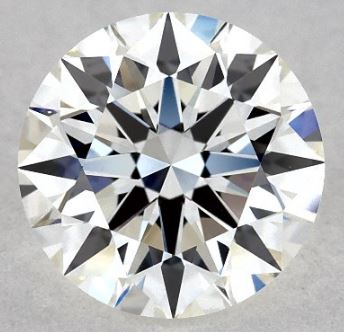
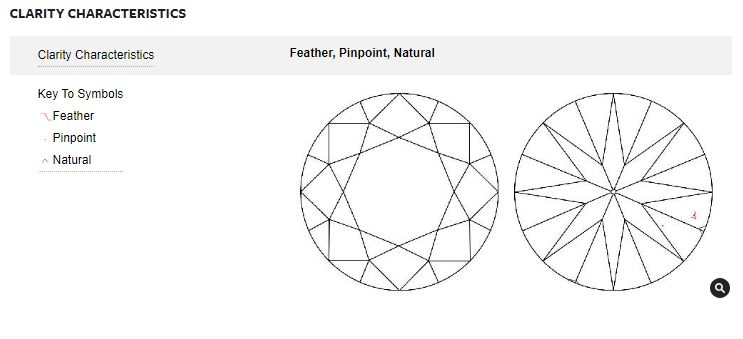
While the VS1 grade gives you an idea of a diamond’s quality, you should not go on grades alone when making a purchase.
Instead of setting out to buy a diamond graded VS1, VS2 or otherwise, you should instead focus on getting the best price you can for an “eye-clean” diamond.
“Eye-clean” means that, while there may be inclusions you can notice under heavy magnification (such as that from a microscope or loupe), typically they aren’t noticeable to the naked eye.
This means you can get a diamond that appears clean and without flaws, without paying a premium for a high clarity grade.
Not all VS1 diamonds are eye-clean, and not all eye-clean diamonds are graded as high as VS1 clarity. The size and shape of a diamond have an effect on how easy it is to notice any inclusions, as does their placement. Some inclusions may be adequately hidden when the diamond is set in an engagement ring.
We developed Ringo, a patented artificial intelligence model, to help you pick out beautiful, eye-clean diamonds. Ringo uses videos of diamonds to determine if they are eye-clean, and filters for other parameters, such as making sure the diamond is well-cut, doesn’t have fluorescence issues and will match the style setting you choose.
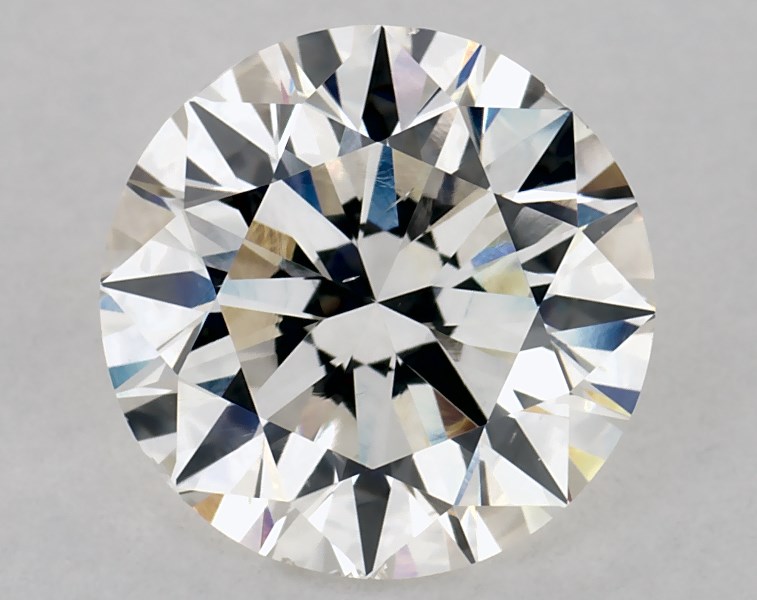


If you want to select a diamond specifically for your personal needs (budget, shape and setting style), check it out here.
It’s impossible to give a standard price for a VS1 diamond, as there are many other factors in play, such as carat weight, color and cut quality. But in terms of value, VS1 diamonds often fall in the sweet spot for getting the best value for money when buying a diamond engagement ring.
The most common mistake people make when buying diamonds is that they purchase a diamond with a clarity grade that’s simply too high to appreciate. An eye-clean VS1 diamond will look identical to a flawless graded diamond assuming all else is equal but will cost significantly less.
We explain more in our guide about what determines the diamond price per carat.
Our many years of experience in the diamond industry have shown us that VS1 and VS2 diamonds offer both excellent value and beauty. We often recommend our readers look for VS1 or VS2 clarity diamonds, as long as they are eye-clean. SI1 and SI2 diamonds can be eye-clean as well, but you need to inspect them (or high-quality photographs) with great care.
In most cases, a VS1 diamond will seem flawless to the naked eye. Not all VS1 diamonds are exactly alike, however, so it’s vital to inspect the diamond thoroughly to ensure any imperfections are not easily spotted or are in locations where they can be easily concealed.
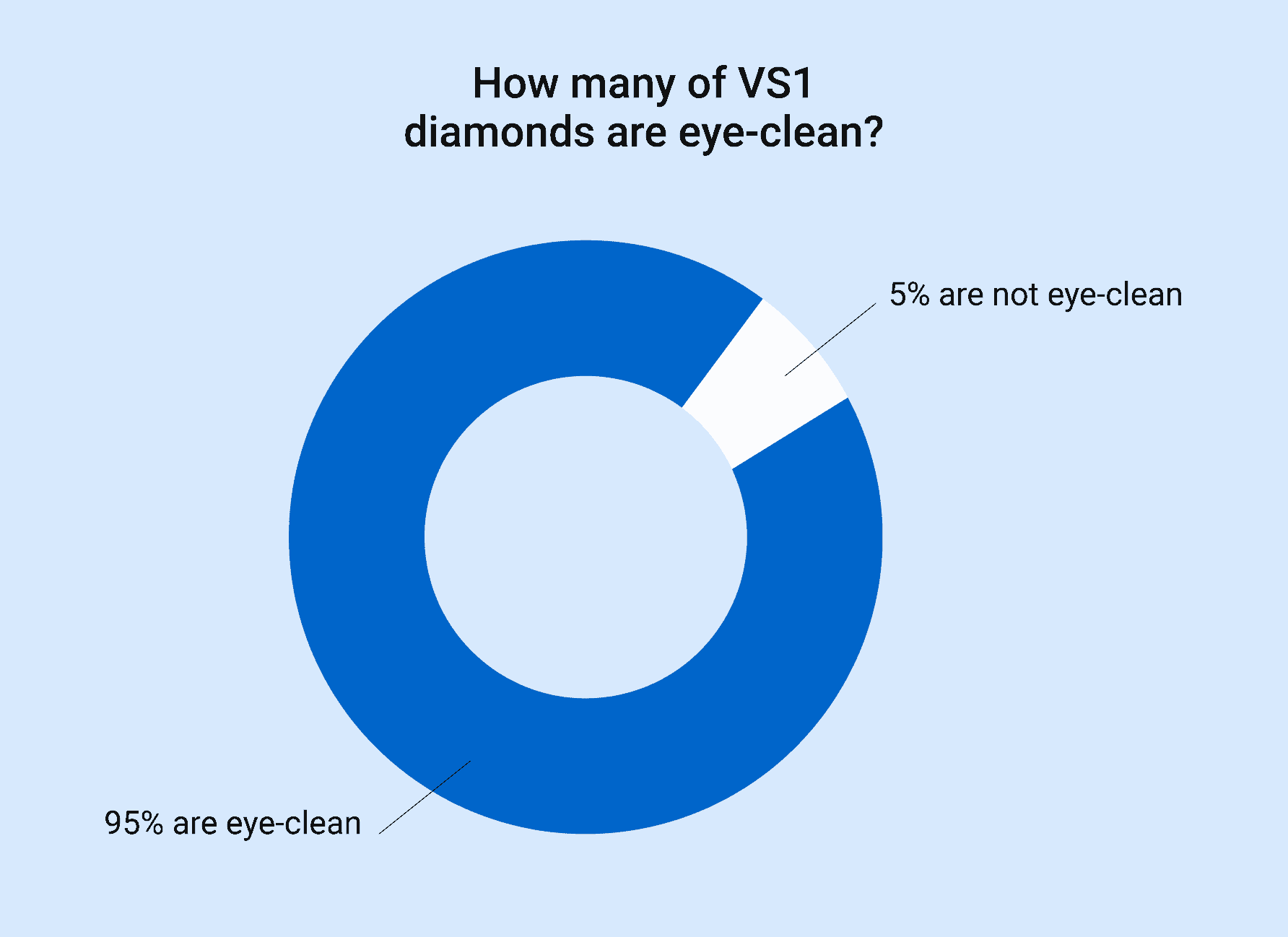
Consider these VS1 diamonds as examples of what you can get at this clarity grade:
Each of these diamonds appears eye-clean at normal magnification. Any of these stones would make for a remarkable diamond ring.
As you increase in carat weight, and inevitably the size of the diamond, there’s a possibility that inclusions will be more visible to the naked eye.
Some larger diamonds—even those with a high clarity grade like VS1 and VS2—may not be eye-clean. For example, this 2.51 diamond with a VS1 clarity from Blue Nile, has a dark inclusion n near the center of the diamond’s table.
In these larger carat weights, you may want to include VVS2 diamonds in your search as well. A beautiful VVS2 clarity grade will have no noticeable inclusions or blemishes.
With 1 carat diamonds, you can feel secure with a VS1 or VS2 grade. As you increase in carat, be sure the diamond is clean of imperfections when you look at it with your naked eye. Without using any magnification aids, you shouldn’t be able to see any flaws or inclusions.
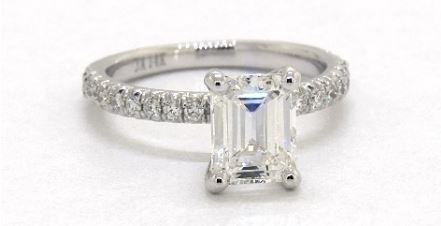
Certain diamond shapes show or hide inclusions better than others. Brilliant cut diamonds, such as round, princess, oval and pear shaped diamonds, generally mask inclusions quite well, meaning you’ll almost always be fine with a VS1 clarity grade.
On the other end of the scale, you have asscher cuts and emerald cuts, which are shapes that contain step cuts. Diamonds with step cuts are either rectangular or square, and have many parallel facets. It’s important to know that step-cut diamond shapes show inclusions the clearest.
For asschers, emeralds and baguette shapes, it’s best to look at every diamond using high-quality 360° photographs (like with James Allen). You may have to bump up to a VVS2 to get an eye-clean diamond with step cuts.
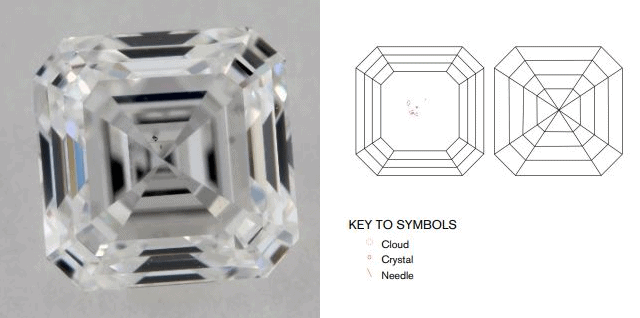
Inclusion plot from the GIA report shows a concentration of clouds in the same vicinity.
As you can see in the images above, an eye-clean diamond isn’t always guaranteed with the VS1 clarity grade. Having an eye-clean diamond is largely dependent on a few factors: color of the inclusions, diamond cut (better light performance helps conceal imperfections), as well as the nature of the flaws.
Here’s another questionable example of a 1.01 carat cushion cut graded with Very Slightly Included clarity. This inclusion may be visible to your naked eye depending on the type of lighting conditions and your eye’s orientation to the diamond.
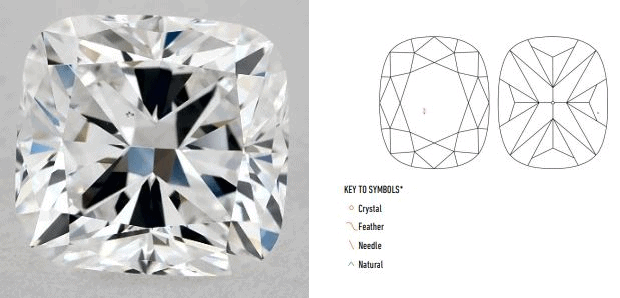
Cushion Cut with dark inclusions under table facet.
Overall, just be sure to review any diamond closely (no matter the clarity grade) to ensure there are no noticeable blemishes and inclusions. If you’d like assistance in reviewing diamonds, please contact our clarity experts.
When comparing VS1 vs VS2 diamonds, it’s often difficult to tell the difference, especially in weights of 1.00 – 2.00 carats. By definition, VS1 is a clarity rating where minor inclusions are somewhat easily detected by a trained professional under 10X magnification. Without using any magnification aids, you shouldn’t be able to see any flaws or inclusions with your naked eye.
VS2 clarity inclusions, on the other hand, are almost always easily noticeable at 10x magnification (a standard jeweler’s loupe). Occasionally, the inclusion will be in a difficult-to-spot location. In most cases, though, the inclusion is large enough to be spotted quickly under magnification.
While VS2 diamonds are usually eye-clean, some outliers exist, especially when it comes to larger-sized diamonds. These outliers usually barely made it past the SI1 grade and have inclusions visible to the naked eye. This is why we stress the importance of reviewing magnified photographs and videos before any purchase.
If you’re stuck debating VS1 vs VS2 diamonds, look at the lower grade and see if it passes as eye-clean. Because of the slight differences between the two, and what you can save by going a grade lower, we recommend looking for eye-clean VS2 diamonds with a carat weight of less than 2.01.
As you increase in carat weight, and the size of the stone, you may want to consider diamonds with VS1 or even VVS2 clarity.
When it comes to clarity, you want to take a close look at the diamond before making a decision. You need to see if the diamond has any inclusions and blemishes at the naked eye level.
In order to look for these imperfections, you need high-tech images. That’s why we recommend buying diamonds online from vendors who offer high-quality photography.
The vendors we recommend that currently offer sufficiently high-quality images for reviewing clarity are James Allen and Blue Nile. With their technology, you’re able to find the perfect diamond.
Here we answer some common questions about VS1 clarity diamonds.
A VS1 diamond is a diamond with a “Very Slightly Included 1” grade in clarity. This grade comes in between VS2 (Very Slightly Included 2) and VVS2 (Very Very Slightly Included 2) on the diamond clarity grading scale.
VS1 clarity diamonds have fewer imperfections (or less noticeable ones) than VS2 diamonds, though both VS1 and VS2 diamonds generally look clear when viewed by the naked eye.
The price of a 1 carat VS1 diamond can range from as low as $3,000 for a diamond with a low grade in color, to $13,000 for completely colorless diamonds with perfect cut quality and proportions. But the price also varies based on the cut quality as well as the shape of a diamond.
The best advice when assessing diamond clarity is to buy the lowest clarity grade that still appears eye-clean. As roughly 85% of VS2 diamonds are eye-clean, these make the better purchase in the majority of cases.
VS1 is a high clarity grade, indicating that any imperfections are very slight and hard to notice. In fact, 95% of VS1 diamonds appear clean to the naked eye, making these diamonds virtually indistinguishable from flawless diamonds under normal viewing conditions.
It’s very rare to find cloudy inclusions in VS1 diamonds. These diamonds are usually eye-clean, meaning they appear clear and transparent to the naked eye.
A nice one carat round diamond that is VS1 clarity costs about $5,200. The price can vary a bit based on which shape you select, what color grade you go with, and whether it’s well cut or not.
Generally, we recommend seeking a diamond with a clarity grade of VS1 to SI2. With a pretty VS1 or VS2 diamond, your stone will look identical to a flawless clarity diamond (assuming all else is equal), yet will cost far less.
While VS clarity diamonds are usually eye-clean, there are definitely exceptions. Take a look at this diamond from Blue Nile as an example of a poor VS quality diamond.
As you increase your carat weight, and inevitably the size of your diamond, more blemishes and inclusions may be visible to the naked eye. For diamonds greater than 2 carat, we recommend looking for diamonds within the VS1 clarity grade. Most importantly, review all potential diamonds closely to ensure that they’re eye-clean.
Shopping for a diamond can be stressful and confusing. With a purchase of this magnitude, it’s best to seek expert advice to help you buy a diamond ring you’re completely satisfied with.
If you’re feeling unsure about diamond clarity, feel free to contact us. After helping thousands of readers, we have plenty of experience sifting through images and deciding whether a diamond is eye-clean or not.
We’ll help you compare VS1 vs VS2 diamonds, to assess whether it’s really worth spending more for a higher clarity grade, and guide you toward the best quality eye-clean diamond that fits your budget.




Before you buy a diamond, get personal buying advice from industry veterans. We'll help you get the best diamond for the money.
DISCLAIMER: We don't use your email for marketing. Period.
A diamonds’ price is determined primarily by the 4 Cs of the diamond. On the wholesale level, diamond prices are first based on a diamond shape and
Buying an engagement ring is often one of the first major purchases in a person's life. The process can be fraught with tension as there are so m
A wide range of 1 carat diamonds exist both in online markets and local diamond jewelry stores. Not only are there significant differences in beauty
Please enter your email address to receive your 25% off coupon code:
Here is your coupon code: GFDSF3GF